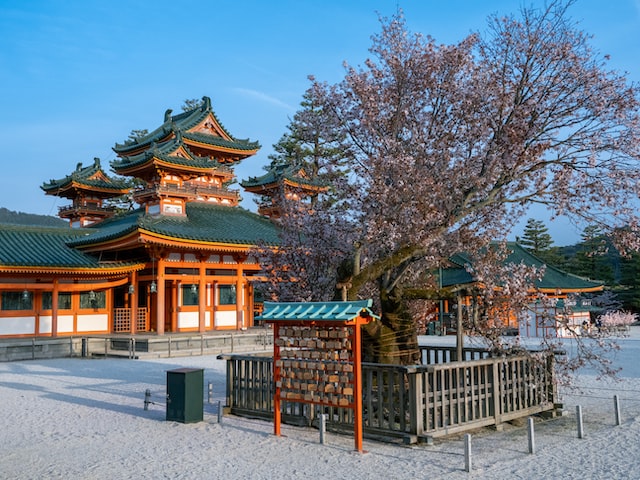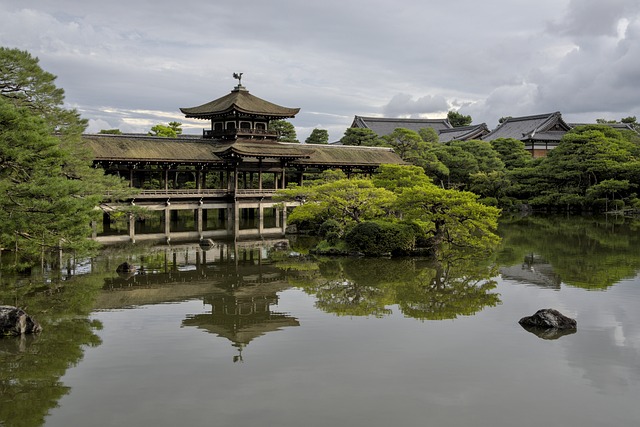Heian Jingu or Heian Shrine is one of the more than 400 shrines in Kyoto. One of the city’s most popular shrines, it’s also touted as an important historical center. Renowned for its beautiful gardens and massive vermillion torii gate, it is designated the top rank as a Shinto religious site.
While many of the Shinto shrines and Buddhist temples in Kyoto are known for their extensive history, Heian Shrine is significantly new. Having only been around for 128 years, it is relatively modern compared to its more ancient counterparts. Aside from its impressive giant torii, the shrine is also renowned for being a replica of the old Imperial Palace. The religious complex is huge and is one of the most popular hanami spots in Kyoto.
A brief background
Built in 1895, Heian Jingu’s history may not be as extensive and colorful as the rest of the temples and shrines in the old capital. The shrine is dedicated to the city’s first and last rulers— Emperors Kammu and Komei.
Due to the historical significance of the shrine, it is designated as the highest-ranked shrine in terms of cultural and historical relevance. For that, it has earned the recognition of Beppyo Jinja, granted by the Shinto Shrine Association.

During its construction, the rest of Kyoto lay in ruins. This was during the fighting that took place ending the Bakumatsu Period. During the Meiji Restoration area, the decision was made to move the capital to Edo, now Tokyo. The decision shattered the spirit of the people living in the city.
However, Kyoto residents remained unfazed and decided that the best thing to do is bring back the glory of the former capital. The construction of Heian Jingu coincided with the 1100th celebration of the capital’s return to Heian-kyo— making it the symbol of the efforts to rebuild the city.
Significance of the shrine
In the 19th century, Kyoto was a mere shadow of its former glory when Tokyo was made the new capital. However, the city was picked to serve as the venue for the 4th National Industrial Exhibition. The government-sponsored event was intended to showcase technological advancement either by locals or foreigners. Kyoto residents saw this as an opportunity to turn things around.
Originally, the event was to take place in 1894. However, since the next year is Heian-kyo’s 1100th anniversary, it was decided to postpone the exhibition instead. The locals played a critical role in this as without their support, the postponement wouldn’t have happened. When the exhibition took place the next year, Heian Shrine plays a central role as the venue host.
The event saw more than 70,000 exhibitors and more than a million visitors flock to Kyoto. An overwhelming success, the exhibition, along with the Heian Shrine, was instrumental in Kyoto’s recovery. It served as a revival of the city as a tourist destination. It also paved the way for the many businesses in the area to once again restart their operations to cater to guests. As such, the Heian Jingu is a revered symbol of the city’s revitalization, also cementing its status as the country’s center of culture.

A replica of the ancient Imperial Palace
While not as grand as the Heian-period Imperial Palace, Heian Jingu is its replica. The only difference is that it’s about a quarter smaller than the original structure. Built to commemorate Kyoto’s 1100th founding anniversary, the shrine underwent major reconstruction in 1979 after it was devastated by a fire in 1976.
When visiting the shrine, visitors are first greeted by a massive, bright red torii— one of the largest in Japan. Second only to the Kumano Hongu Taisha torii, it’s quite hard to miss with its 80-foot height. Another impressive structure within the shrine grounds is the Otemon. It’s a
gate building that leads to the actual replica palace-shrine structure.
Other notable structures within the grounds are the two-story pavilion towers positioned along the west and east of the Great Hall of State or Daigokuden. Known as White Tiger or Byakko-ro and Blue Dragon or Soryu-ro, both these towers were built around the same time as the shrine. Both are also designated as among the country’s important cultural properties.

Massive torii
The massive torii leading to the shrine grounds is one of the very first things that people will see when visiting. At 80 feet tall, it is Kyoto’s tallest torii, although second tallest in the country. It doesn’t hurt that it’s painted in bright vermillion. With legs having a diameter of 11.8 feet, it certainly is hard to miss.

It’s no surprise that it’s one of the shrine’s most popular spots. Many people usually take photos of this part of the shrine. It looks even more magnificent on a clear sunny day. With the blue sky above, its bright red color stands out even more. If you get a chance to visit Heian Jingu when visiting Kyoto, this is one spot you want to capture on camera!
Shrine structures to check out
Many of the structures making up the shrine are designed to replicate the Chodo-in or the State Hall of the Heian-period Imperial Palace. His proved to be quite challenging during the construction process. The old palace was razed to the ground in 1227. As such, the people in charge of Heian Jingu’s construction only had very few documents to serve as a reference.
Originally, the shrine is to be built on the same grounds as the old Imperial Palace. This did not come to fruition, however, due to the many issues they encountered in obtaining the land. Because of this, the shrine was instead built in Kyoto’s Okazaki area.

At 33,000 square meters, the shrine complex is quite extensive. White sand is used to cover the grounds. All the buildings within the complex are designed Chinese-style. This is reflected in the white walls, the vermillion paint as well as the jade roofs.
The shrine’s Shin’en Garden is also one area worth visiting. Impressively, it takes up half of the entire complex! Huge is certainly an understatement. Interestingly, the garden features 4 gardens within. Every garden has a unique style and is intended to represent specific periods in Japan’s history.
Arranged around a central lake, visitors will need to cross a picturesque bridge to see this part of the shrine grounds. A favorite activity among visitors is feeding the turtles and koi fish in the lakes. They’re quite responsive, so if you intend to visit the gardens, make sure to buy some fish feed. Note that while the rest of the shrine can be accessed for free, a minimal entry fee is charged for accessing the lovely gardens.

Events and festivals
Thanks to its expansive courtyard, Heian Jingu plays host to many popular events in the city. In the summer, visitors can enjoy some nighttime Noh Drama on the shrine grounds. Taking place on the 1st and 2nd of June, the Noh performance takes place by firelight.

A very popular festival or Japanese matsuri that takes place here is the Jidai Matsuri. Also known as the Festival of the Ages, it is the shrine’s most important event celebrated annually. One of the Three Great Festivals in Kyoto, it takes place every October 22nd. The festival celebrates Kyoto’s former status as the country’s capital.
During the event, a parade takes place with participants dressing up in traditional clothes. Some also dress as famous historical figures. Commencing at noon, the parade starts at the site of the old Imperial Palace. It then makes its way to the Heian Shrine grounds.
Important things to know
Visitors can access Heian Shrine every day as it is open from 6 AM-5:30 PM. Entering the shrine is free. However, if you wish to see the garden, a ¥600 admission fee is charged. The garden can be accessed from the time the shrine opens until 5 PM.
Higashiyama Station along the Tozai Line is the closest train station to the shrine. You’ll have to walk for about 10 minutes to get to the shrine grounds. If you’re coming from Sanjo Station, however, expect to walk on foot for about 15 minutes. If you want to go by bus, Bus number 5 from Sanjo Station or Kyoto stops at the Jingu-michi. This is the most ideal way to get to the shrine as the bus stop is near the shrine’s entrance.

A beloved and iconic symbol
With its stunning architecture, serene gardens, and rich history, Heian Jingu is a must-visit destination for anyone interested in Japanese culture and history. Come and experience the beauty and tranquility of this iconic landmark, and discover why it has become such an important part of Kyoto’s revitalization.
